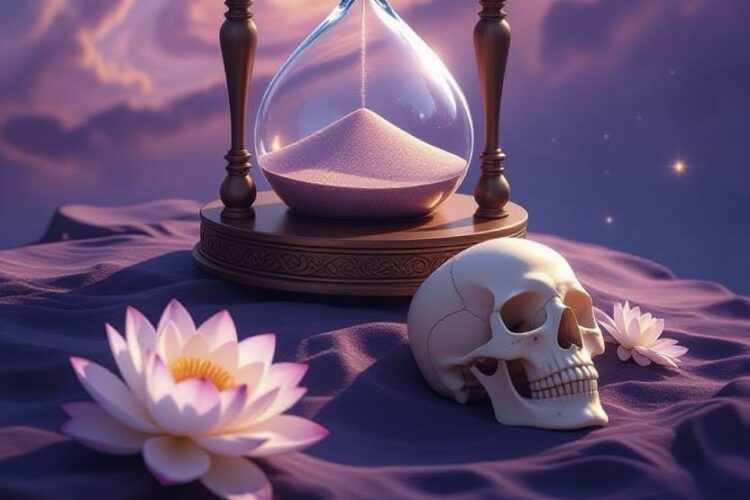Why does life begin only to end? This question probes the heart of existence, blending science, philosophy, religion, and psychology. Scientifically, life emerges through natural processes, driven by entropy and evolution, with death enabling resource renewal and species survival. Philosophically, existentialism sees life as absurd, urging us to create meaning despite mortality, while nihilism views it as meaningless and absurdism finds purpose in rebellion. Religions like Hinduism and Buddhism describe samsara, a cycle of rebirth driven by karma, aiming for transcendence, while Christianity sees death as a gateway to an afterlife. Psychologically, mortality fuels purpose, as suffering highlights life’s value and legacy offers immortality. In 2025, as longevity research grows, life’s impermanence—memento mori—urges us to live meaningfully, transforming fate into a call for renewal and authentic existence.
Long Version
The Enigma of Existence: Why Life Emerges Only to Fade
The question—“Why does the world give life, only to take it away?”—strikes at the core of the human condition, probing the impermanence that defines our mortality. This inquiry into the cycle of birth and death has haunted philosophers, scientists, and spiritual seekers for millennia, revealing life’s fleeting nature as both a source of suffering and a catalyst for profound meaning. In exploring this, we confront fate and destiny, the renewal inherent in endings, and the ontology of being itself—questions that span epistemology, from how we know our purpose to the essence of consciousness. Drawing from diverse viewpoints, this article delves into scientific, philosophical, religious, and psychological lenses, offering a complete resource on the interplay of life and death.
The Scientific Lens: Entropy, Evolution, and the Inevitable End
From a biological standpoint, life isn’t bestowed with intent but emerges through natural processes governed by entropy—the universe’s tendency toward disorder. Self-replicating molecules spark existence, leading to complex organisms via evolution and natural selection, where death ensures resource renewal and species adaptation. Mortality isn’t cruelty; it’s a built-in program completing the life cycle, from gestation to senescence, allowing ecosystems to thrive. Without it, overpopulation would deplete resources, halting progress. Harvard philosopher Susanna Siegel notes how death shapes awareness covertly, giving urgency to finite spans divided into stages of growth and decline. In physics, this mirrors cosmic cycles: stars birth and explode, their remnants fueling new life. Even biological immortality exists in species like jellyfish, but for humans, aging evolves from reproductive trade-offs, with mortality rates rising post-fertility. Nobel laureate Venki Ramakrishnan’s work on aging underscores this: death quests for immortality, yet it’s evolution’s tool for diversity. Causes of morbidity shift across life—from congenital defects in youth to external factors like accidents—highlighting impermanence as a survival mechanism. Ultimately, science views death not as theft but as the renewal enabling existence’s continuity.
Philosophical Depths: Existentialism, Nihilism, and the Absurd
Philosophy transforms this cycle into a quest for purpose amid suffering. Existentialism, as in Jean-Paul Sartre’s works, posits life as absurd—thrown into a meaningless world where we forge our own destiny through choices, defying mortality’s shadow. Nihilism rejects inherent meaning, viewing existence as a void where values dissolve, amplifying the pain of impermanence. Albert Camus’ absurdism builds on this, likening life to Sisyphus’ eternal toil: the clash between our craving for order and the universe’s chaos breeds suffering, yet rebellion—embracing the absurd—yields transcendence. In “The Myth of Sisyphus,” Camus urges finding eudaimonia, or flourishing, despite fate’s indifference. Ancient thinkers like Epicurus saw death as cessation of sensation, nothing to fear, while memento mori traditions remind us to live virtuously. Freud’s thanatos, the death drive, explains our subconscious pull toward endings, balancing life’s eros. Death marks non-experience, yet it intensifies the human condition’s urgency. Ontology questions what it means to be alive, while epistemology probes how we know purpose in a finite span. Mortality gives profound significance, turning limited days into a canvas for discernment. Philosophy thus reframes the end not as loss but as the context for authentic existence.
Religious and Spiritual Horizons: Samsara, Karma, and the Afterlife
Religions offer renewal beyond physical death, viewing the cycle as a path to transcendence. In Hinduism and Buddhism, samsara—the wheel of birth, death, and rebirth— is driven by karma, where actions dictate future existences until enlightenment achieves moksha or nirvana, breaking impermanence’s grip. Anatta, the no-self doctrine, underscores suffering from attachment, with rebirth as a loop of consciousness evolving. Christianity frames life as a divine gift, death as a portal to eternal afterlife, where resurrection redeems mortality’s sting. Islam and Judaism emphasize judgment post-death, with destiny tied to faith and deeds. Reincarnation appears across traditions, from ancient beliefs to modern research, suggesting souls persist beyond one life. David Icke questions a loving God’s role in suffering, urging reevaluation of reality. Indigenous views see death nourishing new birth, a harmonious renewal. Spiritual perspectives counter nihilism by positing purpose in cosmic balance, where mortality tests the soul. Non-existence precedes birth, implying cycles like reincarnation offer continuity. These views transform death from finality to a gateway, infusing existence with eternal meaning.
Psychological and Humanistic Insights: Suffering, Meaning, and Legacy
Psychologically, awareness of mortality—thanatos—fuels both fear and growth. Viktor Frankl’s logotherapy posits suffering reveals purpose, turning impermanence into a drive for eudaimonia. The human condition thrives on contrast: without ends, joy lacks depth. Disconnection from soul amid abundance can starve us of meaning. Literature, like Tolstoy’s “The Death of Ivan Ilyich,” critiques unexamined lives, urging confrontation with mortality for authentic existence. Camus’ influence persists in art, where life’s absurdity inspires creation. Transcendence comes from legacy—reproducing or contributing to the continuum, making us immortal through impact. Yet, societal ills like abortion and euthanasia devalue life, viewing it as expendable. Psychology warns against false beliefs eroding purpose, advocating truth-facing for renewal. In essence, embracing suffering fosters resilience, turning the cycle into a source of profound insights.
Synthesis: Embracing the Cycle for Deeper Living
The world’s gift of life, only to reclaim it, isn’t capricious but integral to existence’s fabric. Science explains the mechanics, philosophy the absurdity, religion the transcendence, and psychology the personal meaning. Whether through entropy’s decay, samsara’s wheel, or existential defiance, mortality imparts urgency—memento mori urging purposeful lives. In a 2025 world of advancing longevity research, this question persists, reminding us that true eudaimonia lies in navigating impermanence with consciousness and grace. By integrating these facets, we transform fate’s decree into destiny’s call, finding renewal in every end.
Hashtags For Social Media
#Existentialism #Philosophy #MeaningOfLife #Mortality #Impermanence #LifeAndDeath #MementoMori #Absurdism #Nihilism #PhilosophyQuotes #ExistentialCrisis #LifeQuotes #DeathQuotes #Stoicism #Wisdom #Inspiration #Motivation #Spirituality #Zen #Buddha #Samsara #Karma #Afterlife #Reincarnation #HumanCondition #Fate #Destiny #Renewal #Transcendence #Eudaimonia
Related Questions, Words, Phrases
why does life exist just to end | what is the purpose of birth and death | why create life only to destroy it | meaning behind life’s cycle of creation and demise | why does the universe grant life then revoke it | philosophical reasons for mortality | why birth leads inevitably to death | existential explanation for why life is temporary | what does impermanence of life mean | why does existence include death | reasons life is given and taken away | why the world allows life but ensures its end | deeper meaning of living and dying | why does nature birth things only to kill them | scientific view on why life ends | why is life fleeting and finite | religious perspectives on life and death cycle | why grant consciousness just to extinguish it | understanding the enigma of birth death renewal | why does fate give life then claim it back | psychological insights into mortality’s purpose | why create beings only for them to perish | the absurdity of life emerging to fade | why does destiny include death after birth | buddhist take on why life is impermanent | why the cosmos produces life but demands its return | exploring why existence is bookended by nonexistence | christian explanation for why god gives and takes life | why evolution designs life to end | nihilistic view on life’s temporary gift | why does suffering come with the cycle of life and death | the mystery of why vitality leads to oblivion | why is human life a brief spark in eternity | karmic reasons behind birth and death | why does the world tease with life before snatching it | existential crisis: why live if death awaits | why nature’s renewal requires death | hindu samsara: why life reincarnates and ends | why consciousness arises only to dissolve | absurdism and the pointlessness of life’s end | why grant purpose through life then erase it with death | evolutionary biology on mortality’s role | why does impermanence define our existence | the human condition: birth death and meaning in between






